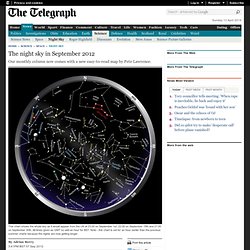

HSS >> Astronomy Section >> Special Events. In the past the predictability of the sky meant that it was used as both a clock and a calendar.

But there are random or infrequent events which generate special public interest. During these times the observatory is opened to help the public get a greater appreciation of the majesty of the heavens. In the past this has included comets, eclipses, transits and unusual planetary events. In addition to these sky-driven concerns we also open the observatory for more human considerations. Science week is a good example of this. News Service Current News Sign up for our notification service. NEA (Near Earth Asteroid) 2012 DA14 Close approach to Earth Near Earth Asteroid DA14 will be making a close approach to Earth on February 15 at 19:26 Hrs. Two new comets will grace the skies in 2013. But it is comet ISON that could become the brightest comet seen since the Great Daylight Comet of 1910.
On the morning of June 6th, Venus will be in transit against the disk of the rising Sun. Stargazing Live Top. HSS >> Astronomy Section >> Observatory. Inbox (96) - bill - Bill Brookman Productions Ltd. Mail. Programmes - Stargazing LIVE - Audio guides. Programmes - Stargazing LIVE - How To Guides. The night sky in September 2012. With the coming of autumn we get the first glimpse of the winter constellation of Taurus the Bull.

One of the first object to appear in it is the Pleiades cluster, perhaps the most spectacular sight in the whole northern sky. It is easy to recognise the Pleiades. It does not look like a star, but rather as if one had poured a collection of stars into the night and they had all collected in the same place. The Seven Sisters of the Pleiades can be seen at various times from almost every dwelling place on Earth, from the high Arctic to the southern tip of South America.
They are older and more famous than any stars—being first mentioned by Chinese astronomers as early as 2357 BC. Just to the east of the Pleiades is one the brightest of all stars, Aldebaran. But this is illusory, like so many shapes in the sky. North of Aldebaran is the Crab Nebula, the remnants of one of the most famous supernovae, seen to explode in 1054 AD and which shone as a bright star for two years. Jodrell Bank Centre for Astrophysics. Highlights of the Month April - Mars at Opposition.

Image NASA. Mars, lying above Spica in Virgo, reaches opposition on April 8th when its magnitude will be -1.5 and its angular diameter 15.1 arc seconds. Due to the fact that Mars, and to a lesser extend, the Earth have elliptical orbits, its distance from us at opposition can vary from ~54 to 102 million km. As a result the angular size will vary from ~13 to 25 arc seconds - a major difference. April - it is still worthwhile to view Jupiter. Jupiter imaged by Damian Peach Jupiter is now well past opposition but this is a still a good month to observe this giant of planets.
The features seen in the Jovian atmosphere have been changing quite significantly over the last few years - for a while the South Equatorial Belt vanished completely (as seen in Damian's image) but has now returned to its normal wide state. See more of Damian Peach's images: Damian Peaches Website" Features in Jupiter's atmosphere - December 2013. 1st 22:44 23rd 21:01.